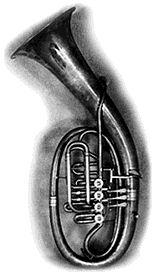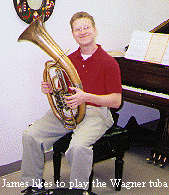 |
A Brief History of Horn Evolution
5. A Branch of the Family Tree
THE WAGNER TUBA
The German word for Wagner Tubas is "Tuben," which in the German
language is plural. However, some English speaking musicians use the word
"Tuben" when referring to only one Wagner Tuba, adding an "s"
("tubens") to speak of more than one. Notwithstanding improper grammatical
usage, they are speaking of one of the branches of the horn's family tree.
This brass instrument and relative of the horn was invented in the late
1800's to meet the specifications of the German opera composer Richard Wagner. He wanted
an instrument that would add depth to the brass section and provide a tonal color that
would bridge the colors of the horn and the trombone.

|
It is usually played with a French horn mouthpiece by a horn player, though the
instrument is otherwise quite different from the French horn. It is in an oval shape, held
in the lap of the player, with the bell pointing up. The outer bell diameter is smaller
than that of a horn. But the throat of the bell is much wider. It is almost wide
enough for the player to stick his or her whole arm inside the instrument, though unlike
the horn, the player does not even place the hand in the bell. The resultant tone is
open, pure and very direct almost to the point of being brash, unlike the relatively
veiled and distant quality of the horn with its backward pointing bell covered always by a
player's hand. And due to the very wide throat of the bell, the sound is bigger and darker
than the trombone. It is the perfect sound for depicting the bad guys in Wagner operas, or
the spiritual majesty of a Bruckner Symphony. |
Originally built either in B flat or F (tenor tuba or bass tuba), several companies in
the Twentieth Century also started making a double Wagner Tuba, combining both B flat and
F, on the same principal as a double horn.
A single Wagner Tuba has four, in-line, rotary valves manipulated by the left hand. The
valves work in the same manner as on most French horns: first valve lowers the pitch by a
whole step, 2nd valve by a half step, 3rd valve by one and a half steps. The 4th valve
(very rare on the horn, but common on the Wagner Tuba) lowers the pitch by two and a half
steps (a perfect fourth). On the double, there are three in-line valves, and a thumb valve
which changes the key of the instrument from F to B flat.
Wagner used them in all four operas in "The Ring." Bruckner used them in his
Symphonies 7, 8 and 9, and Stravinsky used two in "The Rite of Spring." Other
composers like Richard Strauss, Edgard Varese, Arnold Schoenberg, and even the
contemporary composer Christopher Rouse have all used Wagner Tubas in their orchestral
works. Hollywood has also discovered the Wagner Tuba, it was first used in the 1968 film
"Ice Station Zebra."

|
Some horn players dislike playing the Wagner
Tuba because it is inherently out of tune and requires lots of fussing and a very good
sense of intonation to play it well. Others love that challenge, especially because on
most engagements where they are asked to play on both horn and Wagner Tuba, the contract
specifies that the player be paid "doubling" fees - an extra percentage (up to
50%) higher than the basic rate paid for the engagement if playing on just one instrument. |
- End of Exhibition Gallery Tour -
 Back to CyberHorn Museum Main Page Back to CyberHorn Museum Main Page
This is hornplanet.com
HOME
|| HornPage | St. Louis Brass | Opus 90 | Bacon | Golden Horn
|
Store | Food
|| CONTACT
 |
Copyright © Thomas Bacon
1996 - 2009
All rights reserved |
Site Design by Horndog
www.horndoggie.com |

|
|